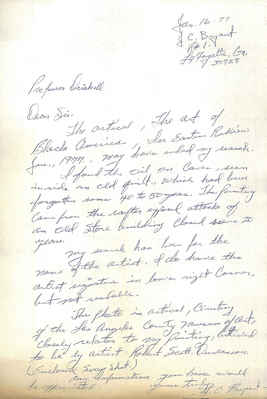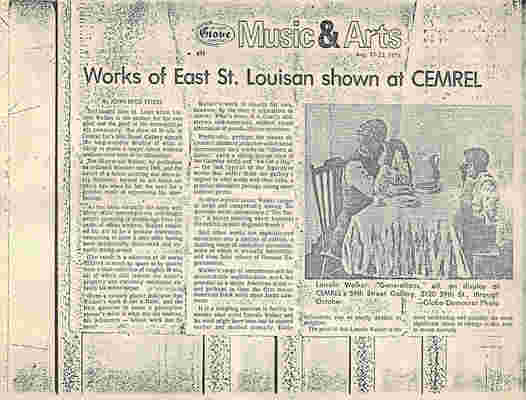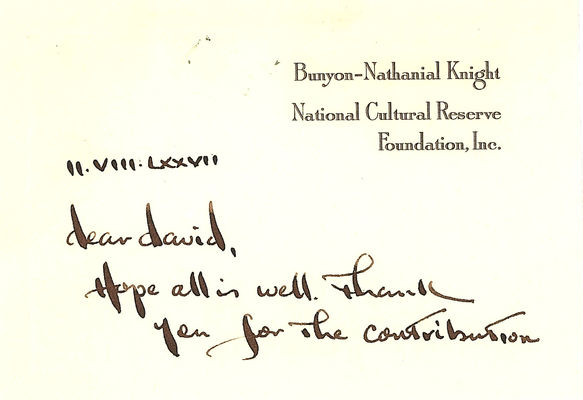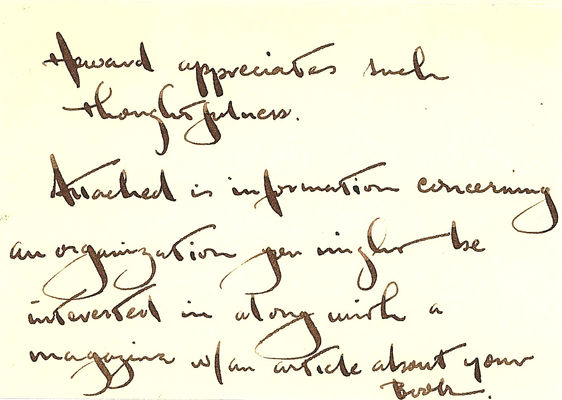Pages
MS01.02.01.B03.F01.0005
Jan. 16. 77 J. C. Bryant R# 1- LaFayette, Ga. 30728
Professor Driskell
Dear Sir. The artical, The Art of Black America, In Eastern Review Jan., 1977. may have ended my search.
I found the oil on cavas, sewn inside an old quilt., which had been forgotten some 40 to 50 years. The Painting Came from the rafter exposed attack of an Old Store building Closed some 20 years.
My search has been for the name of the artist. I do have the artist signature in lower right Corner, but not readable.
The photo in artical, Courtesy of the Los Angeles County Museum of Art, Closely relates to my Painting, believed to be by artist Robert Scott. Duncanson. (Enclosed Snap Shot.)
Any Information you have would be appreciated. Yours truly,
J. C Bryant -
MS01.02.01.B03.F01.0015
[image alt text: newspaper article St Louis Globe Democrat Music & Arts Aug 21-22 1976
Works of East St. Louisan shown at CEMREL By JOHN BROD PETERS
Self-taught East St. Louis artist Lincoln Walker is too modest for his own good and the good of the metropolitan art community. His show of 20 oils at Cemrel Inc's 59th Street Gallery signals the long-overdue display of what is likely to prove a major talent hitherto undiscovered west of the Mississippi.
The 55-year-old Walker, by profession an ordained minister since 1943, and the owner of a house-painting and decorating business, turned to art some six years ago when he felt the need for a graphic mode of expressing his inner feelings.
As has been virtually the norm with many other contemporary self-taught artists springing in middle-age from the ranks of urban workers, Walker intended his art to be a private statement, consenting to show it only after having been accidentally discovered and virtually strong-armed.
The result is a selection of 20 works dictated as much by space as by quality from a total collection of roughly 50 oils, all of which still remain the artist's property and currently constitute virtually his entire output.
Even a cursory glance indicates that Walker's work is not a fluke; and the first question to enter a perceptive viewer's mind is what are his sources, his influences — whose work has he seen?
Walker's work is clearly his own, however, by the time it crystalizes on canvas. What's more, it is clearly midstream mid-American, without visual affectation of pseudo-African overtones.
Predictably, perhaps, the viewer encounters standard primitive urban social commentary such works as "Ghetto at Sunset" (with a telling distant view of the Gateway Arch) and "We Got a Hog" — the last typical of the figurative works that suffer from the gallery's neglect to label works with their titles, a practice defensible perhaps among more abstract pieces.
In other stylistic areas, Walker ranges at large and cometently among '30s Amerian social commentary ("The Party," a recent painting which keynotes the exhibit, is pure Reginald Marsh.)
Still other works are sophisticated excursions into a species of cubism, a dazzling range of controlled surrealism, some of which is virtually hierarchic, and even faint echoes of German Expressionism.
Walker's range of competence and his unmistakable sophistication mark his potential as a major American artist — and perhaps in time the first major American black artist since Jacob Lawrence.
It is a tempting exercise in futility to wonder what artist Lincoln Walker and his work might have been had he started earlier and studied formally. Early
[image paintint] Lincoln Walker: "Generations," oil, on display at CEMREL's 59th Street Gallery, 3120 59th St., through October. —Globe-Democrat Photo influences can as easily deaden as enlighten.
The point is that Lincoln is the
most interesting and possibly the most significant talent to emerge in this area in recent memory.
MS01.02.01.B03.F01.0028
Bunyon-Nathaniel Knight National Cultural Reserve Foundation, Inc. II.VIII.LXXVII dear david, Hope all is well. thank you for the contribution
MS01.02.01.B03.F01.0029
Howard appreciates such thoughtfulness.
Attached is information concerning an organization you might be interested in along with a magazine w/an article about your B[?].
MS01.02.01.B03.F01.0030
The Washington Post Thursday, March 25, 1976 [image caption: Photos by Linda Wheeler-The Wasington post . Jean McKee , left, and Mrs. Ralph Bunche listen as Sen. Edward Brooke addresses the Cultural Reserve gathering: below, reception host Nat Knight.] [image alt text:Jean McKee is on the left, while Mrs. Ralph Bunche is listening to Senator Edward Brooke on the right. All three are in front of a portrait of Frederick Douglass.] Keeping It in Reserve By Jacqueline trescott A larger-than-life portrait of abolitionist and statesmen Frederick Douglass gazed solemnly from the Walnut panelled walls of the Capital reception room. Underneath the painting by Washington artist Simeon Knox, place there just for a reception last night, Dorothy Porter, one of the country's for most bibliographers, embraced Ruth Bunche, the widow of scholar and Nobel Prize winner Ralph Bunche. Mrs. Porter joke about how about she and Bunche used to play tennis at 7 o'clock every morning and in the Howard University courtyard Sen. Edward Brooke (R-Mass.), who hosted the dedication ceremony for the National Cultural Reserve, recall that Bunche was his first political science teacher at Howard. "His early lessons help me find employment in later years," Brooke said and pause to wait for the laughter. Still in its formative stages, the Reserve is a foundation that will try to preserve ethnic cultural contributions through biographical registries and other projects. Its first registry devoted to black Americans, and last night's kick-off reception were dedicated to Bunche by the founder Bunyon-Nathanial Knight. "We thought Bunche was the perfect hero for our children- the original Horatio Alger story," said Knight, a 33-year-old black from Baltimore who works at Howard University and also is an artist. "I always admired him when I was small I wanted to be like him." Bunche, who won the Nobel prize in 1950, also served as undersecretary-general the United Nations until shortly before his death in 1971. Besides Mrs. Ralph Bunche, who lives in New York and was introduced by Brooke as an "admired, respected woman of African descent," Ralph Bunch Jr., a banker, and Peggy Mann, author of recent biography of Bunche , attended. Because Knight has built a reputation as a go-getter, or in the words of Louise Gore, head of the Maryland Bicentennial Commission, " a person with great intuition who knows how to enlarge upon ideas," he attracted a good surprising mix of people. Back in 1971 Knight was the person who got the Kennedys and New York socialites out to the opening of Bedford-Stuyvesant Restoration Corporation exhibit at the Metropolitan Museum of Art. so a flock of ambassadors, historians, State Department folks, cultural types like Darrold Hunt, assistant conductor the Baltimore Symphony Orchestra, impresarios like Patrick Hayes, and people with old names like Anne Weaver Teabeau, the great granddaughter of Douglas, entered the invitation with The Currier & Ives print of the first "colered" senator and representatives. Iranian Ambassador Ardeshir Zahedi seem to having an intimate conversation with assistant Secretary of State John Richardson and the throng. Zahedi recalled a meeting with Bunche and Iran and said, "he was respected for his attitude, firmness and knowledge." Jean McKee, administrator of the American Revolution Bicentennial Administration, recalled a college field trip to United Nations: " Ralph Bunche took 45 minutes out to talk to us and I decided if that was what a public servant was, that's what I wanted to do." [image alt text: Photo of receptionist host Nat Knight laughing.] Among the projects planned by the. Reserve are children's editions of the registers, the collections of historical memorabilia for archives like the Howard Moreland-Spingarn Collection, raising money for Howard's Bunche scholarship and a photographic portrait series of blacks in Congress, last night represented by Andrew Young of Georgia and Parren Mitchell of Maryland. The Reserve will depend on funds. said Knight, from sales, from private donations and corporations. As each person left the reception he or she was given a package of matches with black personalities on the cover, the first completed project of the Reserve, donated by Universal match Company of St. Louis






